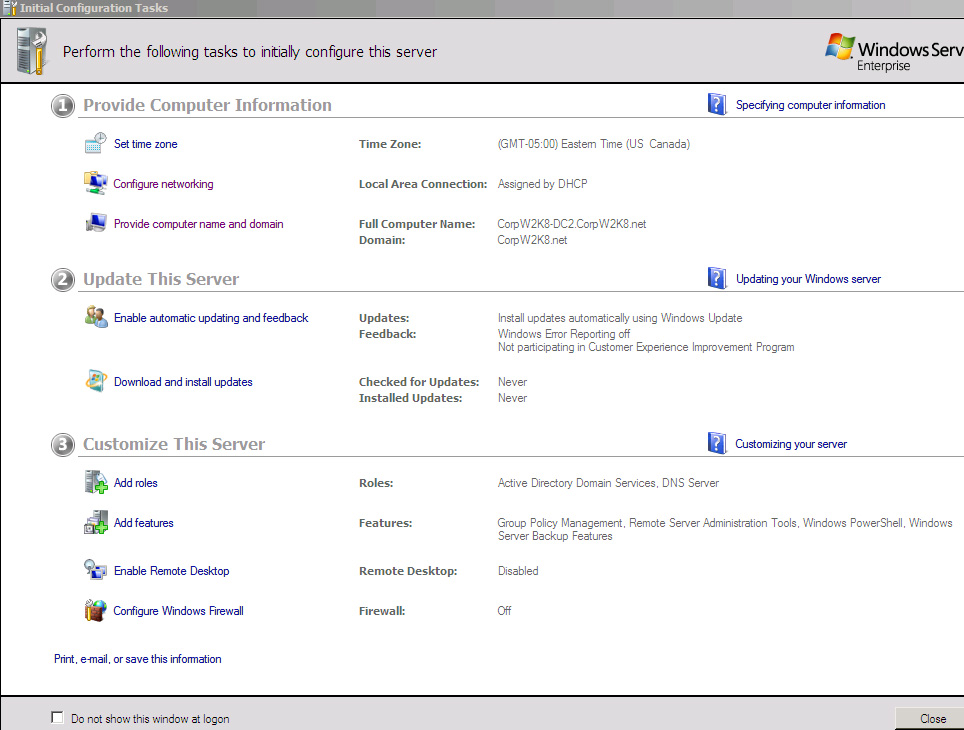

- Windows server 2008 find files by date install#
- Windows server 2008 find files by date update#
- Windows server 2008 find files by date windows 10#
- Windows server 2008 find files by date pro#
- Windows server 2008 find files by date windows 7#
See my site for a growing list of additional articles on these subjects.Īs you may all know, setting the right time, date and time zone on a windows machine is crucial for it to properly function, especially in an Active Directory environment.

Since there are virtually no graphical tools to use in Server Core, one must be able to configure its settings via Command Prompt, PowerShell or other means. You can read more about it on my upcoming “ Understanding Windows Server 2008 Server Core” article.
Windows server 2008 find files by date install#
This method of installation is called “Server Core”, and it allows an administrator to only install the minimum binaries required to run a specific server role (currently, there are 9 possible Server Core roles).
Windows server 2008 find files by date update#
Once you've backed it up, you can then update/overwrite/etc the desired template files with newer versions or additional templates as desired.Į.g., if you currently have WS2008R2 templates versions in your CS, and want to use domain GP via GPMC to manage settings for Win10 computers, you'll need to update your CS with the newer templates, because newer settings introduced for Win10 are only availableįor further detail, and things to consider, please check this blog post by MSFT (and the linked references within that post):ĭon Į.g.As noted in previous articles, Windows Server 2008 has an interesting option to install it with a minimal graphical user interface (or GUI for short).

This requires you to back it up (since SYSVOL is automatically replicated to all DCs via DFS, any change you make to it will be replicated rapidly, including any mistakes or deletions ) Now that you have correctly implemented your CS upon SYSVOL, you should maintain that folder content correctly. When implementing the CS, you must copy *all* templates that you want yo use not only the 'new' template of interest :) This is why, when you copied *only* the WUDO template to your newly implemented CS on SYSVOL, *only* the WUDO template was visible within GPMC. When you implement a CentralStore, by placing the \policydefinitions\ folders onto the SYSVOL of your DC, this causes *all* GPMC scenarios to completely ignore their local \policydefinitions\ folders and forces GPMC to read the \policydefinitions\ from the When you use the default upon GPMC/GPME/RSAT computers to administer Domain-GP, the ADMX/ADML files are always loaded from \windows\policydefinitions\ folders sourced from the local computer (the computer where GPMC is running). There is no impact whatsoever to existing GPO processing, if the entire ADMX/ADML files were non-existent *existing* GP would still continue to process just fine.

We have one environment which has WS2003 DCs and serves Win10 clients perfectly fine (and whilst WS2003 was still supported at the time, this was a totally MSFT supported scenario)Īdmin Templates (ADMX/ADML files), are not involved in the processing/applying of GP - templates are only used for creating/modifying/viewing GP, and used for rendering the gpresult reports/RSoP when you are examining/diagnosing GP. There is no GP 'compatibility' issue regarding the OS version of your DCs vs the OS version of your domain-members/clients.
Windows server 2008 find files by date windows 10#
So what should I do to make our Windows Server 2008 R2 compatible with Windows 10 clients in terms of applying latest policies? Is it safe to copy all admx (and adml) files from Windows Server 2012 or 2016 to central repo in Windows Server 2008 R2?Ī better forum for your question, is the dedicated GP forum (since your question relates particularly to GP rather than DS) :) It worked however strange thing happened - after some time I noticed all admx files were gone exceptįor the WUDO admx file (I had to copy them once again from local PolicyDefinitions). One admx file associated with Windows Updates Delivery Optimization, then copied it to the central repository and checked if properly applied. Should I replace all my admx files from current central repository with the latest included in for example Windows Server 2012/2016? I downloaded But this is not the case.Įach Windows version comes with some specific policies - for example Windows 10 has option to share updates and proper policy is included in the form of particular admx file in
Windows server 2008 find files by date pro#
I heard the lock screen policy was removed from Windows 10 Pro (I found this article here - ).
Windows server 2008 find files by date windows 7#
I have created a policy which locks clients' screens after 10 minutes of idleness (they have to re-enter the password) - and the policy works great with Windows 7 but it does not apply to Windows 10 Pro clients. Our company domain is based on Windows Server 2008 R2.


 0 kommentar(er)
0 kommentar(er)
